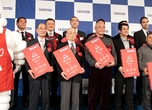A guide to Japanese cuisine
Get to know your oden from your udon

Jugatsu-ya (Kanazawa, Ishikawa)
Posted: Fri Nov 26 2010
The staple food in Japan is rice. Indeed, the word for meal (gohan) literally means 'cooked rice'. In farming communities rice is still eaten three times a day (sometimes noodles are substituted), along with a simple side dish, a bowl of miso soup and some pickles. This is a Japanese meal at its most basic.
Until 150 years ago, meat-eating (especially from four-legged animals) was shunned, and Japanese cooking is still weighted towards seafood and products as tofu, yuba (soya milk skin), natto (fermented beans), soy sauce and miso.
There is a strong emphasis on fresh ingredients, so the varaeties of seafood, vegetables and mushrooms vary throughout the year, reflecting the season. In addition, each region of the country, from Hokkaido down to Okinawa, has its own specialities; all are available in Tokyo. Food quality and hygiene standards are always excellent.
Below is a guide to Japan's amazingly diverse cuisine.
Kaiseki ryori
Japan's haute cuisine developed from the highly formalized light meals that were served with the tea ceremony. Kaiseki consists of a sequence of small dishes, apparently simple but always immaculately prepared and presented to reflect the seasons. Courses follow each other at a slow pace: a one-hour meal would be quick.
The order of the meal is: starter (often highly elaborate); sashimi; clear soup; then a series of dishes prepared in different styles (grilled; steamed; served with a thick dressing; deep-fried; a 'salad' with a vinegar dressing); and finally rice and miso soup, with a light dessert to clear the palate at the end. Kaiseki can be very pricey, though some restaurants serve simplified version for around ¥5,000.
Kushi-age
Pieces of meat, seafood or vegetables are skewered and deep-fried till golden brown in coating of fine breadcrumbs. Usually eaten with a sweetened soy-based sauce, salt or even a dab of curry powder, washed down with beer, and rounded off with rice and miso soup.
Nabemono & one-pot cooking
One-pot stews cocked at the table in casseroles (nabe) of iron or heavy earthenware are delicious and warming in winter. Everyone is served (or helps themselves) from the one pot: you just pluck out what you want using long chopsticks, and dip into the sauce provided. Favourite nabe styles include chicken mizutaki; duck meat; yose (mixed seafood and vegetables); and chanko, the sumo wrestlers' stew into which anything goes.
Noodles: soba, udon & ramen
There are two main indigenous varieties of noodle: soba (thin, grey, made from buckwheat mixed with wheat flour) and udon (chunkier wheat noodles, usually white). These are eaten chilled, served on a bamboo tray with a soy-based dipping sauce; or hot , usually in a soy-flavoured broth. Accompaniments include tempra, grated daikon (radish) or sweetened tofu. Chinese-style ramen noodles are even more popular. These crinkly, yellowish noodles are served in a rich, meat-based soup flavored with miso, soy sauce or cha-shu (sliced, barbecued pork).
Oden
Fish cakes, tofu, vegetables, whole eggs and konnyaku (devil's tongue) are simmered long and slowly in a shoyu-flavoured broth and eaten with a dash of hot mustard. This simple wintertime dish goes wonderfully with sake, and is often served at outdoor yatai (street stalls). Cheap versions can smell chokingly pungent, but the subtle flavor of oden is fine restaurants can be revelation.
(Read Tokyo’s best oden restaurants)
Sashimi
Raw fish, delicately sliced and artfully arranged, is an essential course in most Japanese meals. It is usually served with a dip of soy sauce, plus a dab of pungent green wasabi (or sometimes grated ginger). Best appreciated with some good saké.
Shojin ryori
Japan's long tradition of vegetarian cooking lives on in shojin ryori - Buddhist temple cuisine that generally follows the same lines as mainstream kaiseki, except that no fish is used in the cooking stocks (shiitake mushrooms and konbu seaweed are used instead); garlic and onion are also banned. Tofu and yuba (soya milk skin) feature prominently in shojin meals and also in fucha ryori, a variant with more Chinese influence.
Sukiyaki & shabu-shabu
These meat dishes, both cooked at the table, have evolved over the last century to become key parts of Japanese cuisine. Sukiyaki combines tender cuts of meat (usually beef, but sometimes pork, horse or chicken) with vegetables, tofu and other ingredients, such as shirataki (jelly-like konnyaku noodles), which are lightly cooked in a sweetened soy-sauce broth. As they cook, you fish them out and dip them into beaten raw egg.
Shabu-shabu is paper-thin slices of beef quickly dipped into a boiling cooking stock, usually in especial cooper pot. The name derives from the sound made as the meat is swished to and fro in the broth.
Sushi
The classical style of arranging raw fish or other delicacies on patties of vinegared rice dates back to the 18th century, when sushi became a popular street food in Edo. Top sushi shops can be daunting, as they don't post their prices, and customers are expected to know their uni (sea urchin) from their ikura (salmon roe). The easiest (and cheapest) way to learn your way around the etiquette and vocabulary is to explore the many kaiten (conveyor belt) sushi shops, where prices without having to order. Another style of sushi popular in Osaka and western Japan is chirashi-zushi - large bowls of sushi rice with morsels of fish, egg and vegetables scattered on top.
Tempura
The Portuguese are credited with introducing the idea of deep-frying seafood and vegetables in a light, crisp batter - and also with the name itself. But in Japan the technique has been elevated to a fine art. Premium tempura, cooked one morsel at a time in top-quality sesame oil, should never taste too oily.
Teppanyaki, okonomiyaki & monja
Beef is never cheap in Japan, but Japanese beef (especially Kobe wagyu beef) is a luxury item. The marbled fat lends itself perfectly to being cooked on a flat teppan grilln - Japan's contribution to the art of the steak. Seafood and vegetables are also cooked the same way in front of you.
Okonomiyaki ('grilled whatever you like') is a cross between a pancake and an omelette, stuffed with meat, beansprouts, chopped cabbage and other goodies. Many okonomiyaki restaurants also do yaki-soba (fried Chinese-style noodles). Originally from western Japan (Hiroshima and Osaka both lay claim to it), okonomiyaki is cheap, robust and satisfying. The Tokyo version is known as monja.
Tofu cusine
Tofu and other soya-bean derivatives are celebrated for their protein content and versatility, and feature strongly in Japanese cooking. The silky kinu tofu is considered the most refined version, which you can expect to be served in a top kaiseki meal. The firmer momen, or cotton, tofu is the versatile version. Izakaya will often serve atsuage, a deep-fried cotton tofu topped with bonito flakes.
Tonkatsu
The katsu in tonkatsu means 'cutlet', a very popular dish first introduced during the Meiji period, when meat-eating began to catch on. The katsu is now almost always pork, usually lean cuts of sirloin, dredged in flour, dipped in egg, rolled in breadcrumbs and deep-fried.
(Read Tokyo’s top 5 katsudon)
Unagi
Another of Japan's great delicacies. Fillets of fresh water eel are basted and very slowly grilled (often over charcoal). The delectably rich, fatty white meat is considered a restorative and is said to improve stamina, eyesight and even virility.
(Read Tokyo eel, Kansai-style)
Yakitori
Yakitori ('grilled bird') is the Japanese version of the kebab: skewered morsels of chicken cooked over a grill, seasoned either with salt or slightly sweet soy-based glaze. Most yakitori shops also do wonderful things with vegetables.
Time Out Tokyo Guide (6th edition published in 2010)
Tweets
- About Us |
- Work for Time Out |
- Send us info |
- Advertising |
- Mobile edition |
- Terms & Conditions |
- Privacy policy |
- Contact Us
Copyright © 2014 Time Out Tokyo













Add your comment